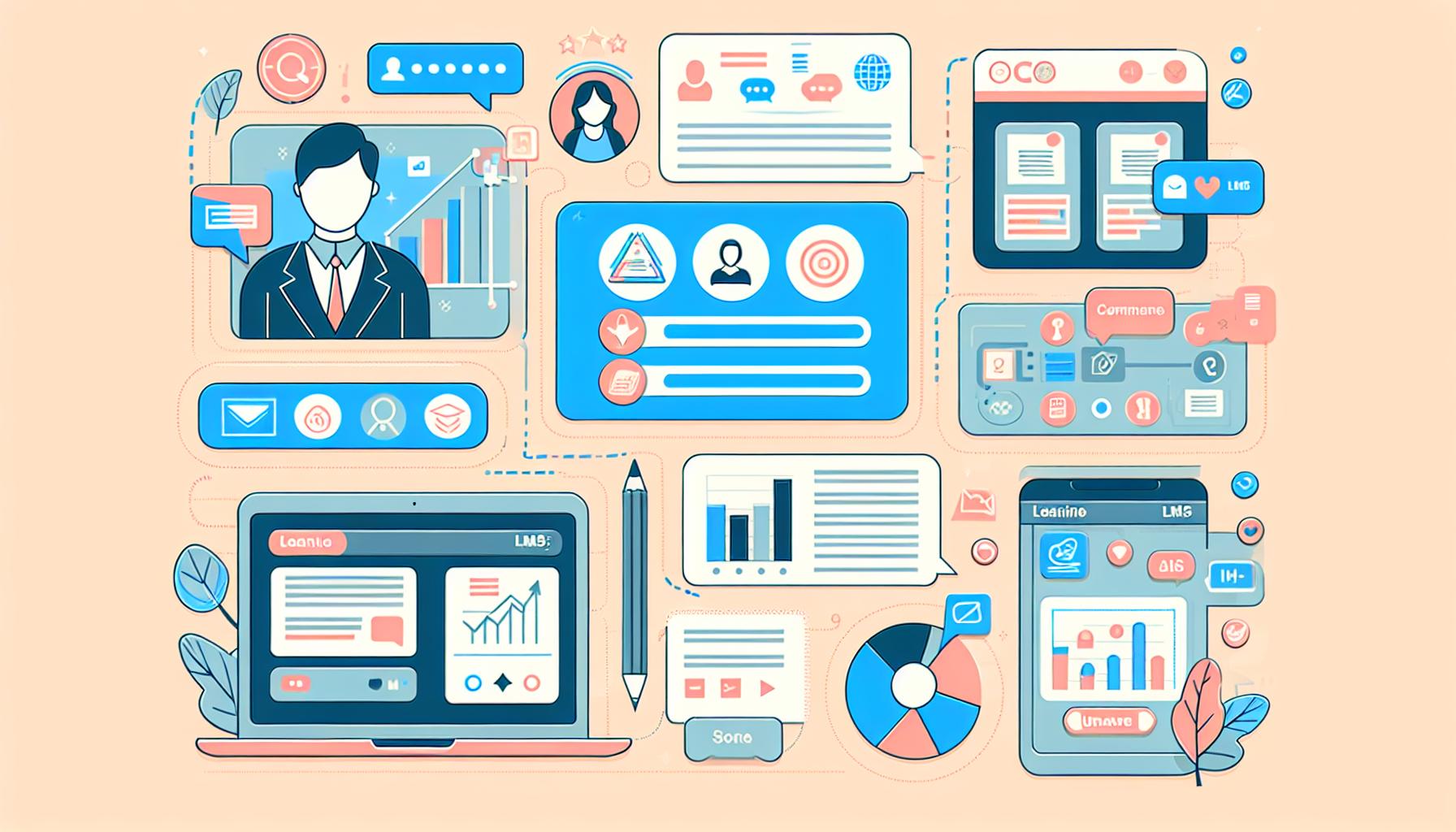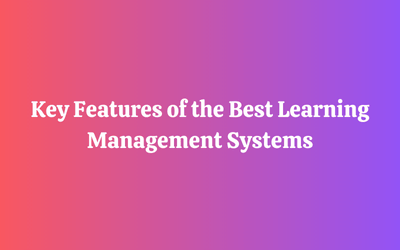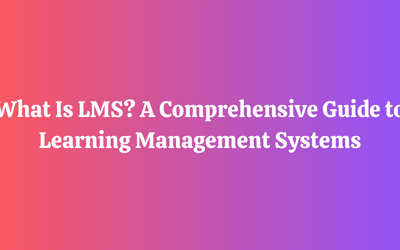How to Improve Learning Management System
Are you looking to enhance the effectiveness of your Learning Management System (LMS)? Whether you’re an educator, administrator, or tech enthusiast, improving your LMS can significantly boost learner engagement and streamline educational processes. With rapid advancements in technology and shifting educational needs, it’s crucial to stay ahead by optimizing your system.
In this article, you’ll discover practical tips and strategies to elevate your LMS experience. From user-friendly interfaces to robust analytics tools, we’ll cover everything you need to create a more efficient and engaging learning environment. Let’s dive into the key elements that can transform your LMS into a powerful tool for both educators and learners alike.
Assessing Your Current LMS

Evaluate the current state of your Learning Management System (LMS) to identify areas for improvement and ensure it meets user needs.
1. Conducting a Needs Analysis
Perform a thorough needs analysis to determine the specific requirements of your organization. Start by identifying key stakeholders such as educators, administrators, and students. Consider their unique needs and expectations from the LMS. Gather data on current usage patterns, pain points, and desired features. Use surveys or interviews to collect this information. Analyze these insights to highlight gaps in functionality or areas where enhancements are necessary.
2. Gathering User Feedback
Collect feedback directly from users to gain valuable insights into their experiences with the LMS. Create structured surveys targeting different user groups including students, instructors, and technical staff. Include questions about usability, feature effectiveness, and overall satisfaction. Encourage open-ended responses for detailed input on potential improvements. Regularly review this feedback to stay informed about user preferences and emerging issues that may require attention.
By systematically assessing your current LMS through these methods, you can build a clear picture of its strengths and weaknesses.
Enhancing User Experience

Improving the user experience in your LMS boosts engagement and satisfaction among learners.
1. Simplifying Navigation and Controls
Simplify navigation to help users find resources quickly. Use clear labels for menus, buttons, and links like “Courses,” “Grades,” or “Assignments” instead of generic terms. Implement a search function that quickly locates content by keywords or topics. Group similar functions together in intuitive categories; for example, place all communication tools such as messaging and forums under one section.
2. Mobile Accessibility
Ensure the LMS is mobile-friendly to accommodate on-the-go learners. Develop a responsive design that adjusts seamlessly across various screen sizes from smartphones to tablets. Optimize loading times by compressing images and using efficient coding practices. Offer offline access for essential materials so students can study without an internet connection when necessary.
Customization and Branding

Customization enhances the LMS experience by creating a unique environment that reflects your organization’s identity.
1. Personalizing User Interfaces
Personalize user interfaces to improve engagement. Allow users (educators, students, administrators) to adjust settings such as color schemes, font sizes, and dashboard layouts. Provide options for customizing navigation menus to streamline access to frequently used features. For example, an educator might prioritize course management tools while a student might focus on assignment submissions and grades. Implementing drag-and-drop functionality can further enhance ease of use.
2. Implementing Custom Themes
Implement custom themes to align the LMS with your brand identity. Create themes that include specific colors, logos, and typography reflecting your organization’s branding guidelines. Use consistent visual elements across all pages to create a cohesive look and feel. Offer multiple theme options so different departments or courses can have distinct yet branded appearances. For instance, science courses could use one theme while arts courses use another without losing overall brand consistency.
By focusing on these customization aspects in your LMS strategy, you ensure a more personalized and engaging learning environment for all users.
Content Strategy and Quality

Enhancing content strategy and quality is crucial for an effective Learning Management System (LMS). Focus on creating engaging, diverse, and interactive content to improve learner engagement.
1. Creating Engaging and Actionable Content
Developing engaging and actionable content directly impacts learner motivation if its addressing “Whats in it for me” from a learner’s perspective. Incorporating clear learning objectives at the beginning of each module helps in defining and visualizing the end goal and its impact on the learner’s job and career in sync with business goals. Use real-world scenarios to illustrate key concepts. For example, case studies in business courses can provide practical insights. Ensure that each piece of content ends with a call-to-action or assessment to reinforce learning outcomes.
2. Diversifying Content Formats
Diversify content formats to cater to different learning preferences. Combine text-based materials, such as articles and whitepapers, with multimedia elements like videos, podcasts, and infographics. Interactive elements such as quizzes or discussion forums encourage active participation. By offering varied formats like these examples, you ensure that learners stay engaged and absorb information effectively.
3. Utilizing Gamification
Incorporating gamification techniques to enhance user experience and bringing the game theory approach of “no one fails” can be a real motivating factor for learners. Implement features such as leaderboards for tracking progress, badges for achieving milestones, and point systems for completing tasks. These elements introduce a competitive aspect that motivates learners. For instance, awarding badges after finishing modules encourages continuous engagement while fostering a sense of achievement among users.
Integration and Scalability

Effective integration and scalability are crucial for maintaining a robust Learning Management System (LMS) that adapts to evolving educational needs.
1. Integrating with Other Systems
Ensure your LMS integrates seamlessly with other critical systems. By connecting it with HRMS can bring in user data and other information automatically and can send their training data to HRMS for better visualization of overall employee performance integration with systems like CRM and DMS (dealer management system) can help in mapping performance with training needs and training outcomes fo any employee, directly from the LMS interface. Employing APIs allows custom integrations tailored to specific organizational needs without compromising functionality.
2. Ensuring Scalability and Future-Proofing
Design your LMS infrastructure to handle growth efficiently. Opt for cloud-based solutions that offer flexible storage options and dynamic resource allocation based on user demand. Regularly update software components to keep up with technological advancements, ensuring compatibility with new devices and platforms. Implement modular architecture so new features or modules can be added without disrupting existing services. Continuously monitor system performance using analytics tools to anticipate potential issues before they affect users’ experience.
User Training and Support

Implementing a Learning Management System (LMS) effectively requires comprehensive user training and ongoing support.
1. Developing Effective Training Programs
Construct targeted training programs to equip users with essential LMS skills. First, identify key areas where users need proficiency, such as navigating the platform, managing content, and utilizing communication tools. Second, create diverse training materials including video tutorials, step-by-step guides, and interactive webinars to accommodate different learning preferences. For example:
- Video tutorials for visual learners
- Step-by-step guides for those who prefer detailed instructions
- Interactive webinars for hands-on experience
Third, schedule regular live training sessions that allow users to ask questions in real-time and receive immediate feedback. Fourth, develop an onboarding process for new users that includes initial orientation followed by progressive skill-building activities.
2. Providing Continuous Support
Establish continuous support mechanisms to ensure sustained user success with the LMS. Create a dedicated helpdesk or support team available via multiple channels such as email, phone, and live chat to address technical issues promptly. Additionally:
- Implement a searchable FAQ section addressing common problems
- Develop a community forum where users can share tips and solutions
- Schedule periodic check-ins or review sessions to gather user feedback directly
Offer access to an online resource library containing updated documentation and troubleshooting guides. By providing robust ongoing support structures alongside initial training initiatives you maximize the effectiveness of your LMS deployment.
Monitoring and Evaluation

Effective monitoring and evaluation are crucial for improving your Learning Management System (LMS). These processes ensure that the system meets educational goals and adapts to evolving needs.
1. Setting Clear Goals and KPIs
Define specific, measurable goals and Key Performance Indicators (KPIs) before starting. For example, aim to increase course completion rates by 15% within six months or boost user satisfaction scores by 20%. Clearly defined metrics allow you to evaluate LMS effectiveness accurately. Engage stakeholders in this process to ensure alignment with organizational objectives.
2. Using Reporting Tools and Data Tracking
Utilize built-in reporting tools within your LMS for comprehensive data tracking. Leverage these tools to monitor student progress, engagement levels, and content effectiveness. For instance, track metrics like average test scores, time spent on modules, and forum participation rates. Use this data to identify trends and areas needing improvement.
3. Regular Reviews and Adaptations
Conduct regular reviews of your LMS based on collected data. Schedule quarterly evaluations involving key stakeholders such as instructors, administrators, and IT staff. Focus on analyzing performance against set KPIs while discussing potential enhancements or necessary adjustments. Adapt the LMS accordingly to address identified issues or leverage new opportunities for improvement.
Encouraging Feedback and Continuous Improvement

Encouraging feedback and fostering continuous improvement are essential for a dynamic Learning Management System (LMS). By gathering and acting on user insights, you can make meaningful enhancements that boost engagement and effectiveness. For example, LMSs like Bytecasting LMS are continuous improving based on user feedback and advanced technology to stay ahead of the competition.
Implementing Feedback Mechanisms
Effective feedback mechanisms provide valuable insights into the LMS. Use structured surveys to gather detailed information about user experiences and satisfaction levels. Conduct regular focus groups with diverse stakeholders like educators, administrators, and students to obtain qualitative data. Implement real-time feedback tools within the LMS interface to capture immediate input on specific features or content modules. Ensure anonymity in these methods to get honest responses, which will help identify areas needing improvement.
Acting on User Feedback
Acting on user feedback demonstrates commitment to continuous improvement. Prioritize the most common issues highlighted by users through your gathered data. Develop action plans that address these concerns clearly and transparently communicate these initiatives to all stakeholders involved. For example, if multiple users report difficulty navigating a particular section of the LMS, consider redesigning that section based on their suggestions. Regularly update users on progress made from their feedback through newsletters or system notifications, reinforcing their role in shaping an effective learning environment.
Final Thought
Enhancing your Learning Management System is a multifaceted endeavor that requires thoughtful planning and execution. By focusing on user-friendly interfaces, robust analytics, mobile accessibility, and personalized experiences, you can significantly improve learner engagement. Don’t forget the importance of diverse content formats and gamification to keep learners motivated.
Integration with other systems ensures seamless operations while scalability prepares your LMS for future growth. Continuous training and support play crucial roles in maximizing effectiveness. Regular monitoring, evaluation, and feedback loops help maintain high standards and adapt to emerging needs.
Ultimately a well-optimized LMS not only meets but exceeds educational demands fostering an enriched learning environment for all users.
Our News
- AI
- Animations
- Articulate
- Articulate 360
- Articulate Engage
- Articulate Live
- Articulate Presenter
- Articulate Quizmaker
- Articulate Replay
- Articulate Review
- Articulate Storyline
- Articulate Storyline 3
- Articulate Studio
- bite sized learning
- Characters
- Content Library
- Corporate Communication
- E-Learning
- e-Learning Authoring Tools
- Employee Engagement
- Game-Based Learning
- Gamification
- Gamiflexer
- Go Sales
- Healthcare
- Instructional Design
- Interactivity
- Knowledge Transfer
- L&D Trends
- Learning
- Learning & Development
- Learning Experience platform
- Learning Management System
- LMS
- LXP
- Microlearning
- mLearning
- Mobile Learning
- Nugget Learning
- Online Training
- Peek
- Performance Support
- Preso
- Quiz and Assessment Platform
- Replay 360
- Rise
- SCORM
- Screen Capture
- Software
- Storyline 360
- Studio 360
- Training Management
- Trainings
- Uncategorized




